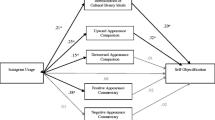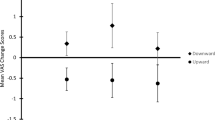Abstract
Based on cultivation theory, self-concept theories, and gender research, this study investigates the influence of TV viewing on female and male consumers' perceived body images and related consumption behavior. The results show that TV viewing biases social perceptions of body images; however, TV viewing does not impact men's consumption behavior. For women, in contrast, TV viewing increases the real–ideal self discrepancy, which, in turn, leads to consumption behavior in order to achieve ideal bodies. For both groups, TV viewing increases body dissatisfaction; also, general beliefs about body images influence related behavior. The results provide some interesting contributions to theory and practice.

Similar content being viewed by others
References
Allgood-Merten, B., Lewinsohn, P. M., & Hops, H. (1990). Sex differences and adolescent depression. Journal of Abnormal Psychology, 99, 55–63.
Bandura, A. (1982). The self and mechanisms of agency. In J. Suls (Ed.), Psychological perspectives on the self. Hillsdale, NJ: Erlbaum.
Baumeister, R. F., & Sommer, K. L. (1997). What do men do? Gender differences and two spheres of belongingness: comment on cross and madson. Psychological Bulletin, 122, 38–44.
Botta, R. A. (1999). Television images and adolescent girls' body image disturbance. Journal of Communication, 49, 22–41.
Bower, A. B. (2001). Highly attractive models in advertising and the women who loathe them: the implications of negative affect for spokesperson effectiveness. Journal of Advertising, 30, 51–63.
Broverman, I. K., Vogel, S. R., Broverman, D. M., Clarkson, F. E., & Rosenkrantz, P. S. (1972). Sex role stereotypes: a current appraisal. Journal of Social Issues, 28, 59–78.
Burroughs, J. E., Shrum, L. J., & Rindfleisch, A. (2002). Does television viewing promote materialism? Cultivating american perceptions of the good life. In S. M. Broniarczyk, & K. Nakamoto (Eds.), Advances in consumer research. Valdosta, GA: Association for Consumer Research.
Comstock, G. (2004). Paths from television violence to aggression: reinterpreting the evidence. In L. J. Shrum (Ed.), The psychology of entertainment media. Blurring the lines between entertainment and persuasion. Mahwah, NJ: Lawrence Erlbaum.
Cross, S. E., & Madson, L. (1997). Models of the self: self-construals and gender. Psychological Bulletin, 122, 5–37.
Dittmar, H., & Howard, S. (2004). Professional hazards? The impact of models' body size on advertising effectiveness and women's body-focused anxiety in professions that do not emphasize the cultural ideal of thinness. British Journal of Social Psychology, 43, 477–497.
Fallon, A. E., & Rozin, P. (1985). Sex differences in perceptions of desirable body shape. Journal of Abnormal Psychology, 94, 102–105.
Fazio, R. H., & Zanna, M. P. (1981). Direct experience and attitude–behavior consistency. Advances in Experimental Social Psychology, 14, 161–202.
Field, A. E., Cheung, L., Wolf, A. M., Herzog, D. B., Gortmaker, S. L., & Colditz, G. A. (1999). Exposure to the mass media and weight concerns among girls. Pediatrics, 103, e36.
Fouts, G., & Burggraf, K. (1999). Television situation comedies: female body images and verbal reinforcements. Sex Roles, 40, 473–481.
Gerbner, G., Gross, L., Morgan, M., & Signorielli, N. (1994). Growing up with television: the cultivation perspective. In J. Bryant, & D. Zillmann (Eds.), Media effects: advances in theory and research. Hillsdale, NJ: Erlbaum.
Gerbner, G., Gross, L., Morgan, M., Signorielli, N., & Shanahan, J. (2002). Growing up with television: cultivation processes. In J. Bryant, & D. Zillmann (Eds.), Media effects: advances in theory and research. Mahwah, NJ: Lawrence Erlbaum.
Gould, S. J. (1993). Assessing self-concept discrepancy in consumer behavior: the joint effect of private self-consciousness and self-monitoring. In L. McAlister, & M. L. Rothschild (Eds.), Advances in consumer research. Provo, UT: Association for Consumer Research.
Groesz, L. M., Levine, M. P., & Murnen, S. K. (2002). The effect of experimental presentation of thin media images on body satisfaction: a meta-analytic review. International Journal of Eating Disorders, 31.
Halliwell, E., Dittmar, H., & Howe, J. (2005). The impact of advertisements featuring ultra-thin or average-size models on women with a history of eating disorders. Journal of Community and Applied Social Psychology, 15, 406–413.
Hamilton, K., & Waller, G. (1993). Media influences on body size estimation in anorexia and bulimia. An experimental study. British Journal of Psychiatry, 162, 837–840.
Hawkins, R. P., & Pingree, S. (1982). Television's influence on social reality. In D. Pearl, L. Bouthilet, & J. Lazar (Eds.), Television and behavior: ten years of scientific progress and implications for the eighties. Rockville, MD: Department of Health and Human Services.
Hendriks, A. (2002). Examining the effects of hegemonic depictions of female bodies on television: a call for theory and programmatic research. Critical Studies in Media Communication, 19, 106–123.
Higgins, T. E. (1987). Self-discrepancy: a theory relating self and affect. Psychological Review, 94, 319–340.
Hughes, M. (1980). The fruits of cultivation analysis: a reexamination of some effects of television watching. Public Opinion Quarterly, 44, 287–302.
Jacobi, L., & Cash, T. F. (1994). In pursuit of the perfect appearance: discrepancies among self-ideal percepts of multiple physical attributes. Journal of Applied Social Psychology, 24, 379–396.
Kendler, K. S., MacLean, C. J., Neale, M. C., Kessler, R. C., Heath, A. C., & Eaves, L. J. (1991). The genetic epidemiology of Bulimia Nervosa. American Journal of Psychiatry, 148, 1627–1637.
Kling, K. C., Hyde, J. S., Showers, C. J., & Buswell, B. N. (1999). Gender differences in self-esteem: a meta-analysis. Psychological Bulletin, 125, 470–500.
Levine, M. P., & Smolak, L. (2002). Body image development in adolescence. In T. F. Cash, & T. Pruzinsky (Eds.), Body image. A handbook of theory, research, and clinical practice. New York: Guildford Press.
Lin, Y.-C., & Raghubir, P. (2005). Gender differences in unrealistic optimism about marriage and divorce: are men more optimistic and women more realistic? Personality and Social Psychology Bulletin, 31, 198–207.
Markus, H., & Nurius, P. (1986). Possible selves. American Psychologist, 41, 954–969.
Markus, H. R., & Kitayama, S. (1991). Culture and the self: implications for cognitions, emotion, and motivation. Psychological Review, 98, 224–253.
Martin, M. C., & Gentry, J. W. (1997). Stuck in the mdoel trap: the effects of beautiful models in ADS on female Pre-adolescents and adolescents. Journal of Advertising, 26, 19–33.
McCreary, D. R., & Sadava, S. W. (1999). Television viewing and self-perceived health, weight, and physical fitness: evidence for the cultivation hypothesis. Journal of Applied Social Psychology, 29, 2342–2361.
McGinnis, J. M., Gootman, J. A., & Kraak, V. I. (2006). Food marketing to children and youth: threat or opportunity? Washington, DC: The National Academies Press.
Milkie, M. A. (1999). Social comparisons, reflected appraisals, and mass media: the impact of pervasive beauty images on black and white girl's self-concepts. Social Psychology Quarterly, 62, 190–210.
Murray, S. H., Touyz, S. W., & Beumont, P. J. V. (1996). Awareness and perceived influence of body ideals in the media: a comparison of eating disorder patients and the general community. Eating Disorders, 4, 33–46.
O'Guinn, T. C., & Shrum, L. J. (1997). The role of television in the construction of consumer reality. Journal of Consumer Research, 23, 278–294.
Pinigitore, R., Spring, B., & Garfield D. (1997). Gender differences in body satisfaction. Obesity Research, 5, 402–409.
Richins, M. L. (1991). Social comparison and the idealized images of advertising. Journal of Consumer Research, 18, 71–83.
Rubin, A. M., Perse, E. M., & Taylor, D. S. (1988). A methodological examination of cultivation. Communication Research, 15, 107–134.
Ruble, T. L. (1983). Sex stereotypes: issues of change in the 1970s. Sex Roles, 9, 397–402.
Schor, J. (1996). Do americans keep up with the Joneses? The impact of consumption aspirations on savings behavior. Working Paper. Harvard University and Tilburg University.
Schouten, J. W. (1991). Selves in transition: symbolic consumption in personal rites of passage and identity reconstruction. Journal of Consumer Research, 17, 412–425.
Secord, P. F., & Jourard, S. M. (1953). The appraisal of body-cathexis: body-cathexis and the self. Journal of Consulting Psychology, 17, 343–347.
Segrin, C., & Nabi, R. L. (2002). Does television viewing cultivate unrealistic expectations about marriage? Journal of Communication, 52, 247–263.
Shanahan, J., & Morgan, M. (1999). Television and its viewers. Cultivation theory and research. Cambridge: Cambridge University Press.
Shipley, R. H., O'Donnell, J. M., & Bader, K. F. (1977). Personality characteristics of women seeking breast augmentation. Plastic and Reconstructive Surgery, 60, 369–376.
Shrum, L. J. (1998). Development of a cognitive process model to explain the effects of heavy television viewing on social judgments. In J. W. Alba, & J. W. Hutchinson (Eds.), Advances in consumer research. Provo, UT: Association for Consumer Research.
Shrum, L. J. (1999). Television and persuasion: effects of programs between the Ads. Psychology & Marketing, 16, 119–140.
Shrum, L. J. (2001). Processing strategy moderates the cultivation effect. Human Communication Research, 27, 94–120.
Shrum, L. J., Burroughs, J. E., & Rindfleisch, A. (2004). A process model of consumer cultivation: the role of television is a function of the type of judgment. In L. J. Shrum (Ed.), The psychology of entertainment media. Blurring the lines between entertainment and persuasion. Mahwah, NJ: Lawrence Erlbaum.
Shrum, L. J., Wyer, R. S., Jr., & O'Guinn, T. C. (1998). The effects of television consumption on social perceptions: the use of priming procedures to investigate psychological processes. Journal of Consumer Research, 24, 447–458.
Silverstein, B., Perdue, L., Peterson, B., & Kelly, E. (1986). The role of the mass media in promoting a thin standard of attractiveness for women. Sex Roles, 14, 519–532.
Sirgy, J. M. (1982). Self-concept in consumer behavior: a critical review. Journal of Consumer Research, 9, 287–300.
Spitzack, C. (1990). Confessing excess: women and the politics of body reduction. Albany: State University of New York Press.
Spitzer, B. L., Henderson, K. A., & Zivian, M. T. (1999). Gender differences in population versus media body sizes: a comparison over four decades. Sex Roles, 40, 545–565.
Stice, E., Schupak-Neuberg, E., Shaw, H. E., & Stein, R. I. (1994). Relation of media exposure to eating disorder symptomatology: an examination of mediating mechanisms. Journal of Abnormal Psychology, 103, 836–840.
Stice, E., & Shaw, H. E. (1994). Adverse effects of the media portrayed thin-ideal on women and in kages to Bulimic symptomatology. Journal of Social and Clinical Psychology, 13, 288–308.
Tan, A. S. (1979). Television beauty Ads and role expectations of adolescent female viewers. Journalism Quarterly, 56, 283–288.
Tapper, J. (1995). The ecology of cultivation: a conceptual model for cultivation research. Communication Theory, 5, 36–57.
Thompson, C. J., & Hirschman, E. C. (1995). Understanding the socialized body: a poststructuralist analysis of consumers self-conceptions, body images, and self-care practices. Journal of Consumer Research, 22, 139–153.
Tiggemann, M. (2002). Media influences on body image development. In T. F. Cash, & T. Pruzinsky (Eds.), Body image. A handbook of theory, research, and clinical practice. New York: Guildford Press.
Tversky, A., & Kahnemann, D. (1973). Availability: a heuristic for judging frequency and probability. Cognitive Psychology, 5, 207–232.
Wansink, B., & Huckabee, M. (2005). De-marketing obesity. California Management Review, 47, 6–18.
Wood, W., Wong, F. Y., & Chachere, J. G. (1991). Effects of media violence on viewer's aggression in unconstrained social interaction. Psychological Bulletin, 109, 371–383.
Author information
Authors and Affiliations
Corresponding author
Rights and permissions
About this article
Cite this article
Eisend, M., Möller, J. The influence of TV viewing on consumers' body images and related consumption behavior. Market Lett 18, 101–116 (2007). https://doi.org/10.1007/s11002-006-9004-8
Received:
Accepted:
Published:
Issue Date:
DOI: https://doi.org/10.1007/s11002-006-9004-8




